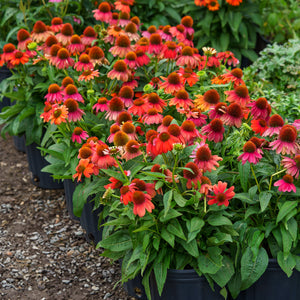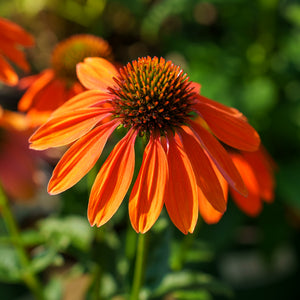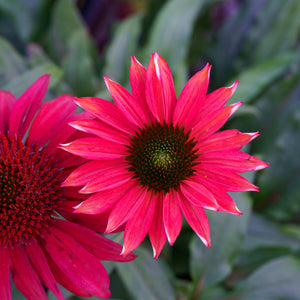The Echinacea Guide
Echinacea, commonly known as coneflower, is a vibrant, pollinator-friendly perennial treasured for its daisy-like blooms and medicinal heritage. Native to North America, Echinacea brings structure, seasonal color, and ecological value to landscapes while thriving in conditions that challenge other plants. With bold, upright stems and signature cone-shaped centers, echinacea has become a modern garden favorite, combining classic prairie performance with exciting contemporary breeding.
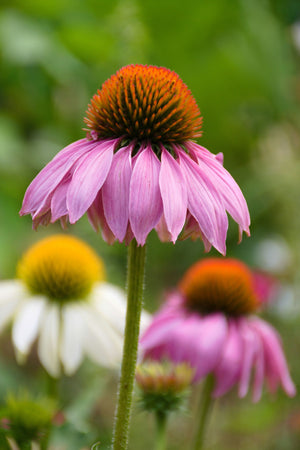
About
The Echinacea genus belongs to the Asteraceae family and includes several species native to central and eastern North America. Historically, Echinacea purpurea and Echinacea angustifolia were revered by Indigenous peoples and later herbalists for their purported immune-boosting properties. Today, they are most often grown for their ornamental value in home landscapes, pollinator gardens, and naturalistic plantings.
Modern cultivars expand far beyond the traditional purple form, offering rich oranges, vibrant reds, sunny yellows, and even green or multicolor blooms. Highlights include Echinacea 'Cheyenne Spirit', a seed-grown mix with a dazzling spectrum of color; the compact and robust 'PowWow Wild Berry' and 'PowWow White'; and the long-blooming 'Sombrero Hot Coral' and 'Sombrero Granada Gold'. The Kismet and SunSeekers series ('Kismet Yellow', 'SunSeekers Rainbow') provide exceptional flower power, while 'Hot Papaya' adds a bold double bloom to the garden. Other standout selections include 'Artisan Red Ombre', 'Artisan Soft Orange', and 'Sweet Fuchsia', each adding new flair to the echinacea palette.
With strong stems, excellent drought tolerance, and rich nectar reserves, echinacea offers lasting appeal to gardeners and pollinators alike.

PLANTING
Planting echinacea correctly sets the stage for vigorous, long-lasting blooms and trouble-free care. Here's how to get it right:
- USDA Hardiness Zones: Hardy in Zones 3–9.
- Soil: Prefers well-drained, loamy to sandy soil. Tolerates poor soils but does not thrive in heavy clay unless amended.
- Sunlight: Full sun (at least 6 hours daily) is ideal for best flowering and strong stems.
- Watering: Water regularly during the first growing season to establish deep roots. Once established, echinacea is highly drought tolerant.
- Spacing: Space plants 16–24 inches apart, depending on the cultivar’s mature size.
- Planting Time: Best planted in spring or early fall. Fall planting allows roots to establish before winter, while spring planting ensures a full growing season.
To plant from seed, start indoors 8–10 weeks before the last frost or sow outdoors after the threat of frost has passed. Cold stratification may improve germination for certain species.
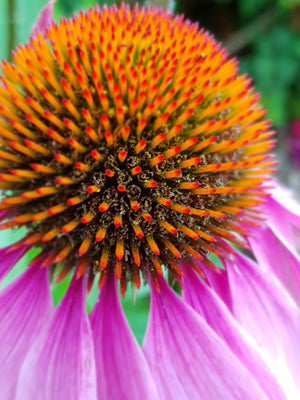
CARE
Echinacea is remarkably low maintenance once established. Follow these guidelines for optimal performance year after year:
- Watering: Water young plants regularly. Mature plants need minimal supplemental water except during prolonged drought.
- Fertilizing: Not typically necessary. In poor soils, apply a balanced slow-release fertilizer in spring.
- Deadheading: Remove spent blooms to prolong flowering. Leave some seed heads late in the season to feed birds and add winter interest.
- Pruning: Cut plants back to the ground in late fall or early spring.
- Dividing: Divide every 3–4 years in spring or fall to refresh overcrowded clumps.
- Pests & Diseases: Generally pest-resistant. Watch for Japanese beetles and occasional issues with powdery mildew in humid conditions.
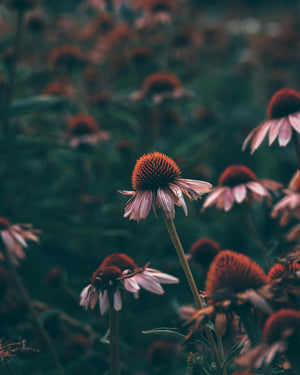
HOW TO USE
Echinacea brings bold texture, height, and season-long color to sunny landscapes. Their versatility makes them a staple in many planting styles:
- Pollinator Gardens: Echinacea is a magnet for bees, butterflies, and hummingbirds.
- Meadow and Prairie Plantings: Natural companions for grasses and native perennials.
- Mixed Borders: Adds vertical structure and contrast to shorter mounding perennials.
- Cut Flower Gardens: Long stems and vibrant blooms make stunning additions to fresh arrangements.
- Drought-Tolerant Landscapes: Perfect for xeriscaping or tough urban planting beds.
Pair Echinacea with plants like rudbeckia, salvia, coreopsis, ornamental grasses, or sedum for a dynamic and low-maintenance planting that supports pollinators and looks good from summer into fall.

COMMON QUESTIONS
- What is Echinacea? Echinacea is a genus of native North American perennials known for their daisy-like blooms and use in traditional herbal medicine.
- When to plant Echinacea? Plant in early spring or early fall for best establishment.
- Is Echinacea a perennial? Yes, echinacea is a hardy perennial in most regions of the U.S.
- Do deer eat Echinacea? Echinacea is generally deer resistant due to its coarse texture and bitter compounds.
- How to grow Echinacea? Plant in full sun with well-drained soil, water to establish, and deadhead for continued bloom.
- Is Echinacea toxic to dogs? Echinacea is not considered toxic to dogs in small quantities but may cause mild stomach upset.
- Is Echinacea toxic to cats? It is also considered non-toxic to cats but should still be kept out of reach if your cat likes to chew.
- How to plant Echinacea seeds? Sow seeds indoors 8–10 weeks before last frost or direct sow after danger of frost has passed. Cold stratification may help germination.
Conclusion
Echinacea blends rugged resilience with cheerful charm, making it a go-to perennial for home gardeners, designers, and pollinator enthusiasts alike. Whether you're planting an entire prairie garden or slipping a few into your border, echinacea rewards minimal care with long-lasting color and ecological value. From the classic purple tones of Echinacea purpurea to new, showy selections like 'Cheyenne Spirit' and 'Kismet Red', these plants deliver visual impact and habitat support season after season.
The Echinacea Collection
Sold Out
Sold Out
Sold Out
Sold Out

